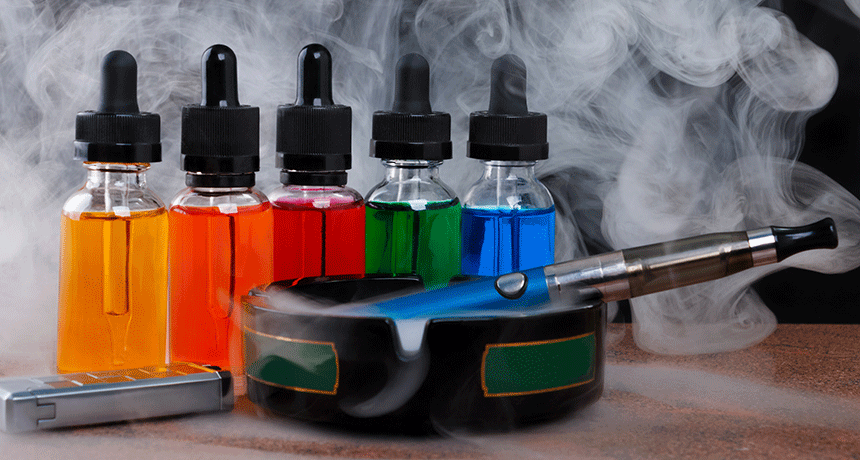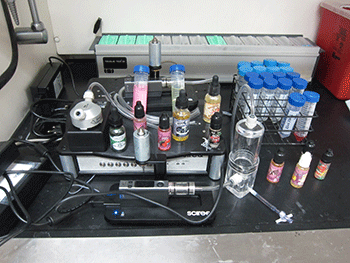E-cigarettes don’t need nicotine to be toxic
Vaped liquids produce gases that can damage and kill human cells

Liquids for electronic cigarettes come in a variety of flavors — with and without nicotine. A new study finds that vapors from even those without nicotine can still poison cells.
MakcouD/iStockphoto
Think electronic cigarettes without nicotine are harmless? Think again. A new study shows that the flavorings in e-cigs can harm human infection-fighting cells.
E-cigarettes work by heating a flavored liquid to make a mist that users inhale, or “vape.” These flavored liquids, called e-liquids, usually contain nicotine. But not always. Manufacturers add nicotine for vapers who want a buzz from their e-cigarettes. It’s the same stimulant that true cigarettes deliver. That nicotine — made from tobacco — qualifies most e-cigs as “tobacco products.”
The nicotine may be useful for adults who are addicted to cigarettes and want to wean themselves off. But nicotine can harm children and teens. That’s why some young people may choose to vape instead of smoke, and use nicotine-free products. But the new data suggest that e-cigs can still be toxic, even without nicotine.
“We know these flavors are really attractive to teens,” says Irfan Rahman. He works at the University of Rochester in New York. He says studies have shown that one reason many teens try e-cigarettes is an interest in fruity and candy-flavored products.
As a toxicologist, Rahman studies whether various materials can poison the body’s cells or tissues. His team decided to test whether certain flavored e-liquids are toxic (meaning poisonous). They tested several common e-liquid flavorings. These included cinnamon roll, cotton candy, melon, pineapple, coconut and cherry.
Such flavorings are considered safe in foods. That’s because after a person swallows them, they’re broken down in the gut. But that doesn’t mean these same chemicals are safe to breathe in. They could harm parts of the respiratory tract, such as the lungs.
Rahman’s team didn’t expose people to these flavorings, in case they were harmful. Instead, they tested e-liquid chemicals on human cells in a dish. This helped them judge whether the chemicals might also harm cells inside the body.
The answer: Some of the vaped flavorings did prove toxic to those cells. The researchers published their findings in the January Frontiers in Physiology.
Cells vs. cinnamon
After a person vapes, e-liquid chemicals could pass through the walls of small vessels in the lungs to enter the blood, says Thivanka Muthumalage. He’s a researcher in Rahman’s lab.
Rahman’s team wanted to know what would happen when these chemicals encountered blood cells. In one set of tests, the researchers exposed blood cells directly to the flavorings. They chose a type of white blood cell called a macrophage (MAK-roh-fayj). These cells are part of the immune system, which fights disease. Macrophages hunt down and “eat” particles that shouldn’t be in the blood stream. Those foreign particles could be germs or other things that might make people sick.
The team used doses of flavoring chemicals similar to what are in the e-liquids that you can buy at a store, says Muthumalage. The doses in the experiment might even have been lower than what people would vape.
To measure how toxic each chemical was, the researchers looked for signs of stress in the cells, or even cell death. A number of e-liquid flavoring chemicals caused high levels of cell stress or death. Those included flavorings that taste buttery (these contain the chemicals pentanedione and acetoin). They also included flavorings that taste like vanilla (O-vanillin), cotton candy, caramel (maltol) and cinnamon (cinnamaldehyde).
That last one, cinnamaldehyde (Sih-nuh-MAAL-duh-hide), killed the most cells. And that’s bad. Dead immune cells can’t fight infection, explains Muthumalage.
His team’s findings are backed up by a study in the March 27 PLOS Biology. Researchers at the University of North Carolina School of Medicine in Chapel Hill tested the effects of 148 e-liquids on human cells. When exposed to vapors of some e-liquid flavors, it showed, fewer of these cells grew. The worst culprits? Cinnamaldehyde and vanillin.
A vaping machine
In a second set of tests, the researchers used a “vaping machine” to suck e-liquids through an e-cigarette. Afterward, they measured what vapors had entered the air. These mists are what an e-cig user would ordinarily inhale. The researchers then exposed human cells to these vapors.

They showed that heating each flavoring in an e-cigarette created harmful levels of molecules that can damage cells. What’s more, mixing two or more flavors together caused even higher levels of these damaging molecules than did heating each on its own.
This suggests that breathing in multiple e-liquid flavors could be more dangerous than exposure to just one at a time.
That’s concerning, says Melanie Prinz. She’s a college student who worked on the study in Rahman’s lab. “Teens at parties often pass their [e-cig] devices around,” she notes. That means they could be “sharing and inhaling a lot of different flavors.”
The findings from Rahman’s lab agree with the findings from another study. It looked at vapors from nicotine-free e-cigs. Here, researchers at the University of California San Francisco studied the urine of teens who had vaped e-liquids without nicotine. The researchers looked for toxic chemicals that form when e-liquids are heated. The teens had up to three times the levels of five potentially cancer-causing chemicals in their bodies as did those who didn’t vape. These findings appear in the April Pediatrics.
That was the first study to measure the toxic chemicals that can get into the bodies of teens vaping nicotine-free e-liquids.
Cause for concern
Maciej Goniewicz works at the Roswell Park Comprehensive Cancer Center in Buffalo, N.Y. There he, too, studies the health effects of e-cig vapors. Testing the toxicity of e-liquid flavoring on cells is extremely important, he says. It helps identify which chemicals may be “bad actors,” he explains.
If these tests show strong toxicity, they could help government agencies decide which products to regulate — or even ban. Such data, he adds, could also help manufacturers create safer vape products.
One benefit of studying cells in a dish, rather than studying actual people, is that you can limit variables, Goniewicz says. For instance, the Rochester team could omit nicotine, a known bad actor. But in real life, people might vape a liquid with nicotine one day and another without nicotine the next day. This could make it harder for scientists to tease apart the effects of flavorings and nicotine.
But cell studies are just one piece of the puzzle. They’re good for identifying potentially toxic chemicals. They don’t, however, tell us about the long-term effects of exposure to them. Human studies will — but they take far longer. A disease may not show up for years or decades after a toxic exposure.
In fact, a large review found that the long-term health effects of vaping are not yet clear. A review is a research paper that gathers the results of other studies. This paper included more than 800 scientific studies — and found cause for concern.
For instance, it found “moderate evidence” that vaping led to more coughing and wheezing in teens, and worse asthma. There is also moderate evidence linking vaping to a short-term rise in blood pressure, and to harmful stiffening of blood vessels. And the review authors found “substantial evidence” that e-cig vapors can damage DNA and cells.
This massive report, released January 23, was issued by the U.S. National Academies of Sciences, Engineering and Medicine.







